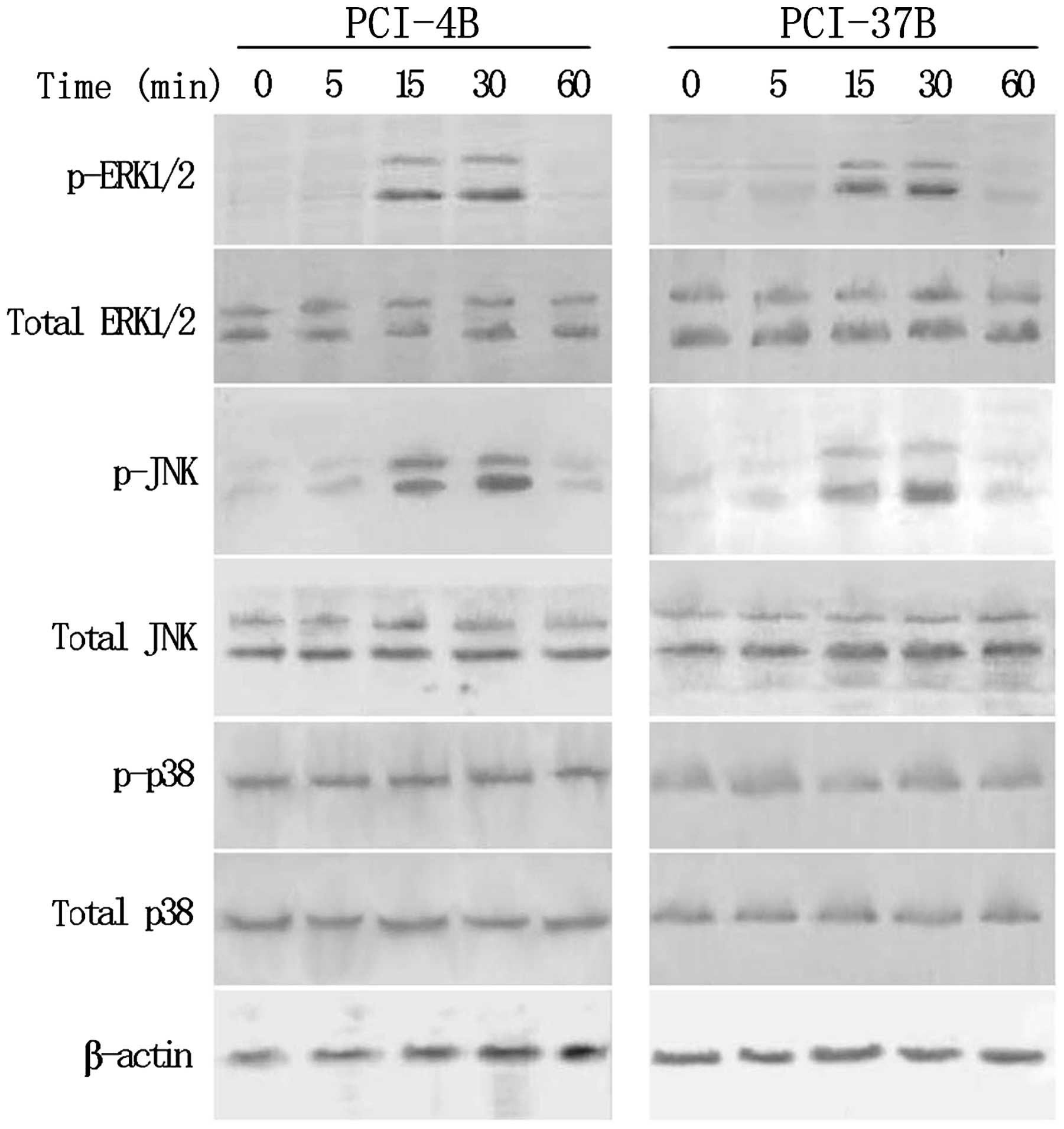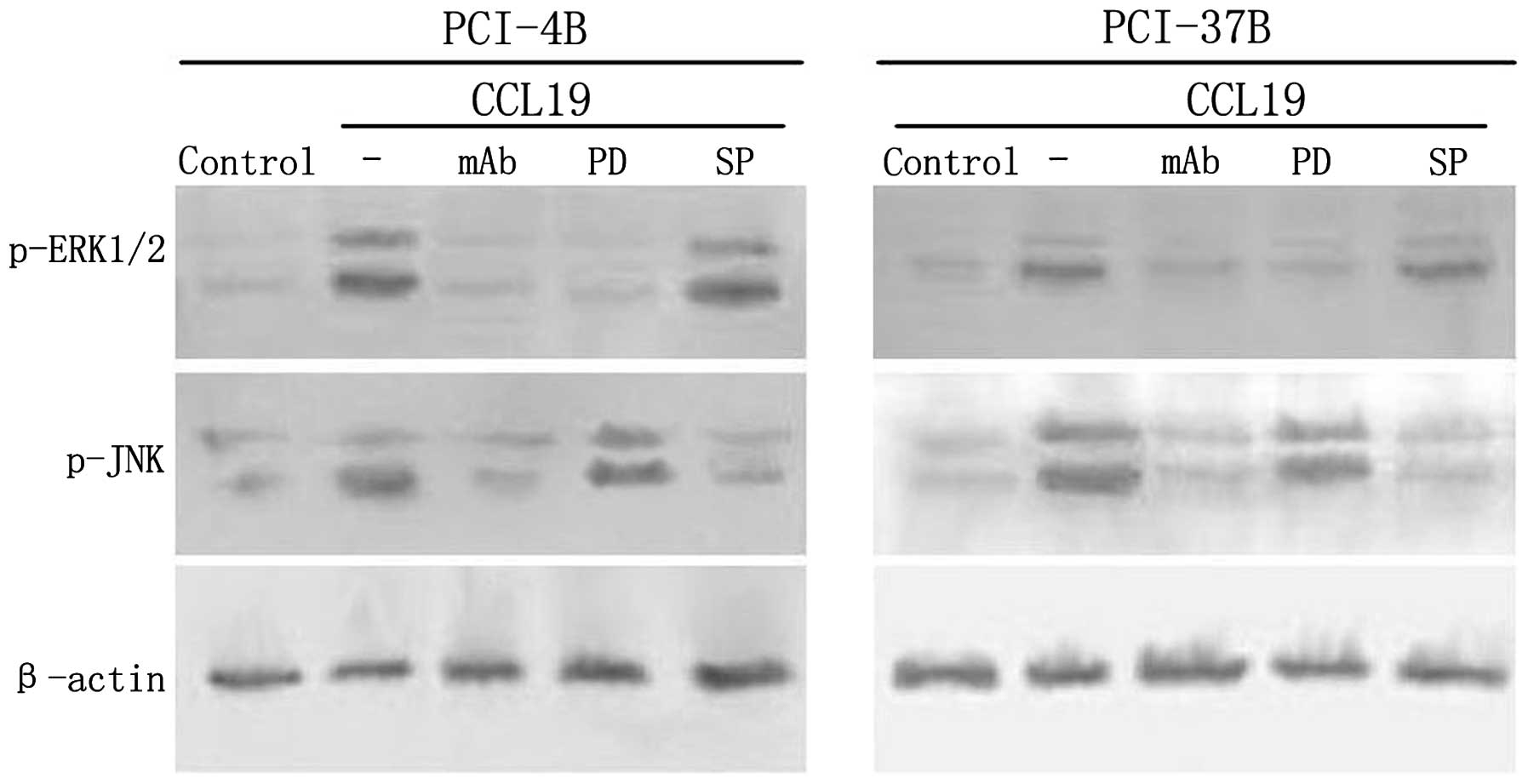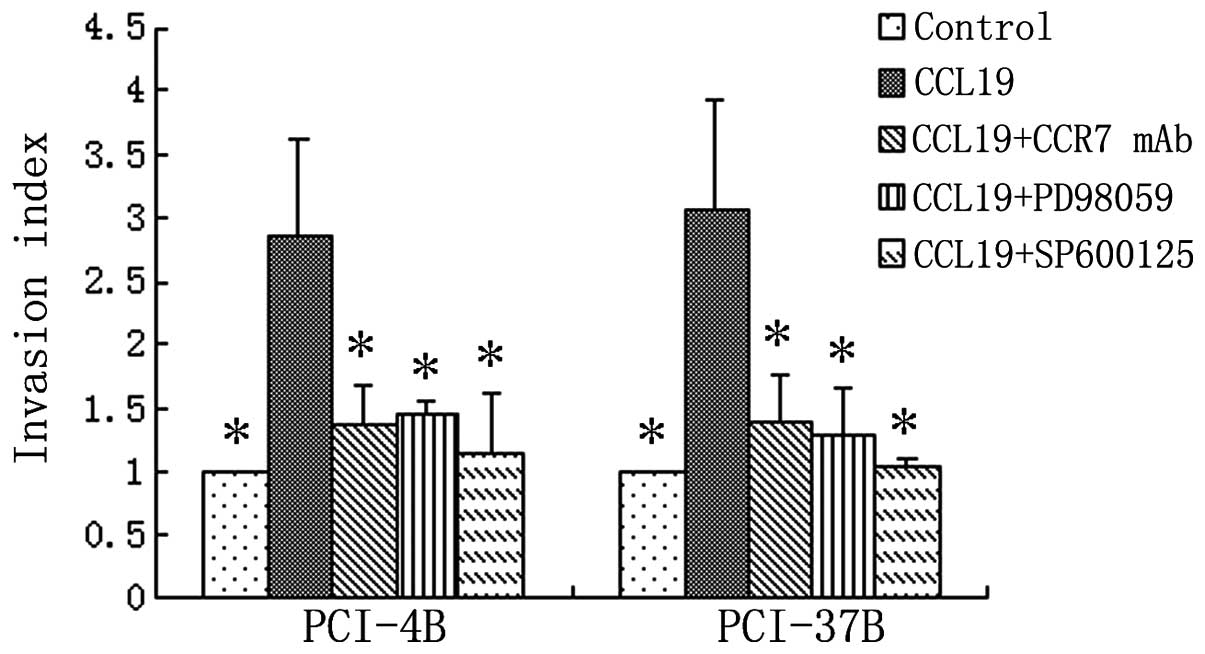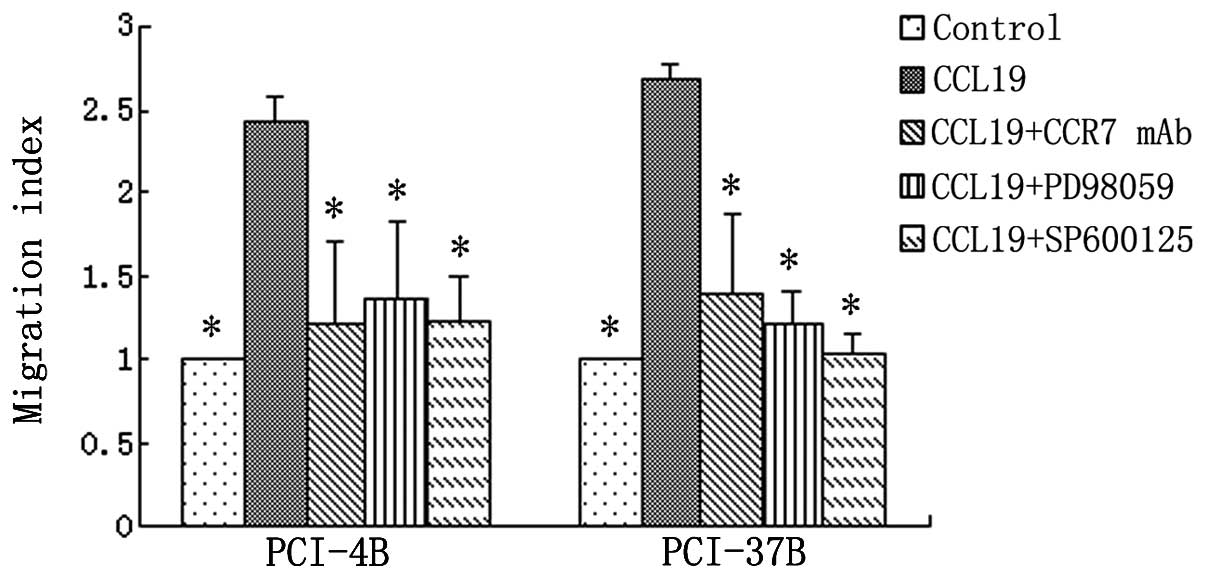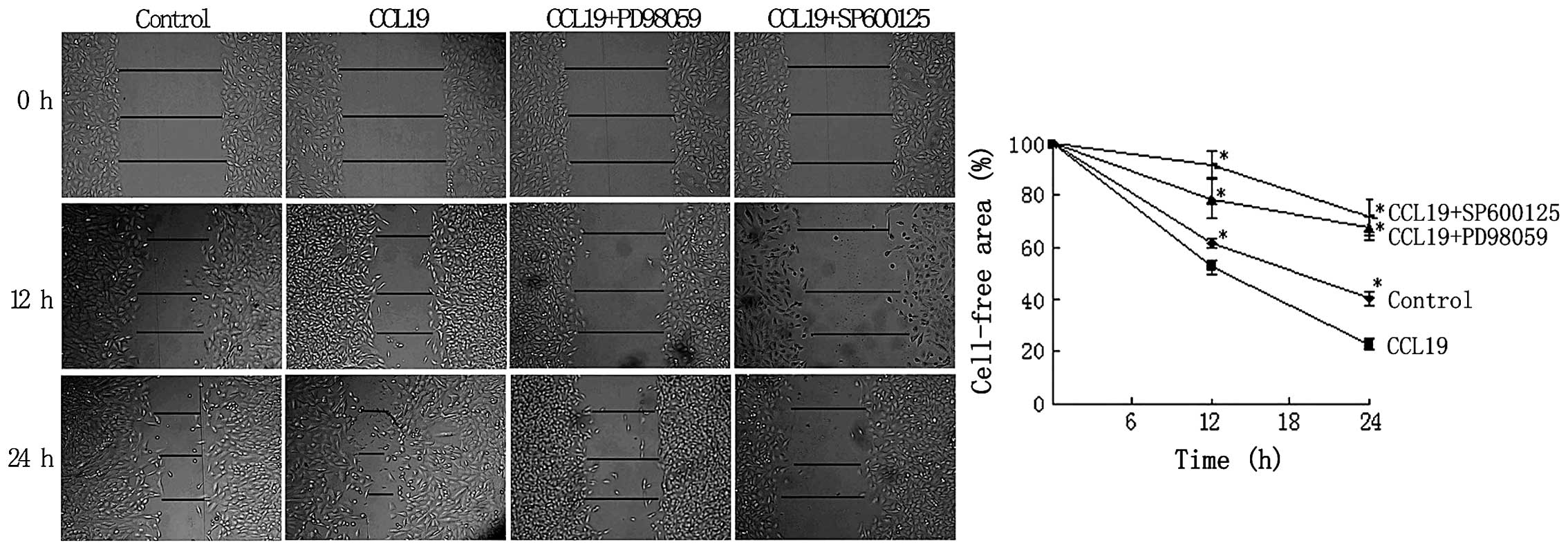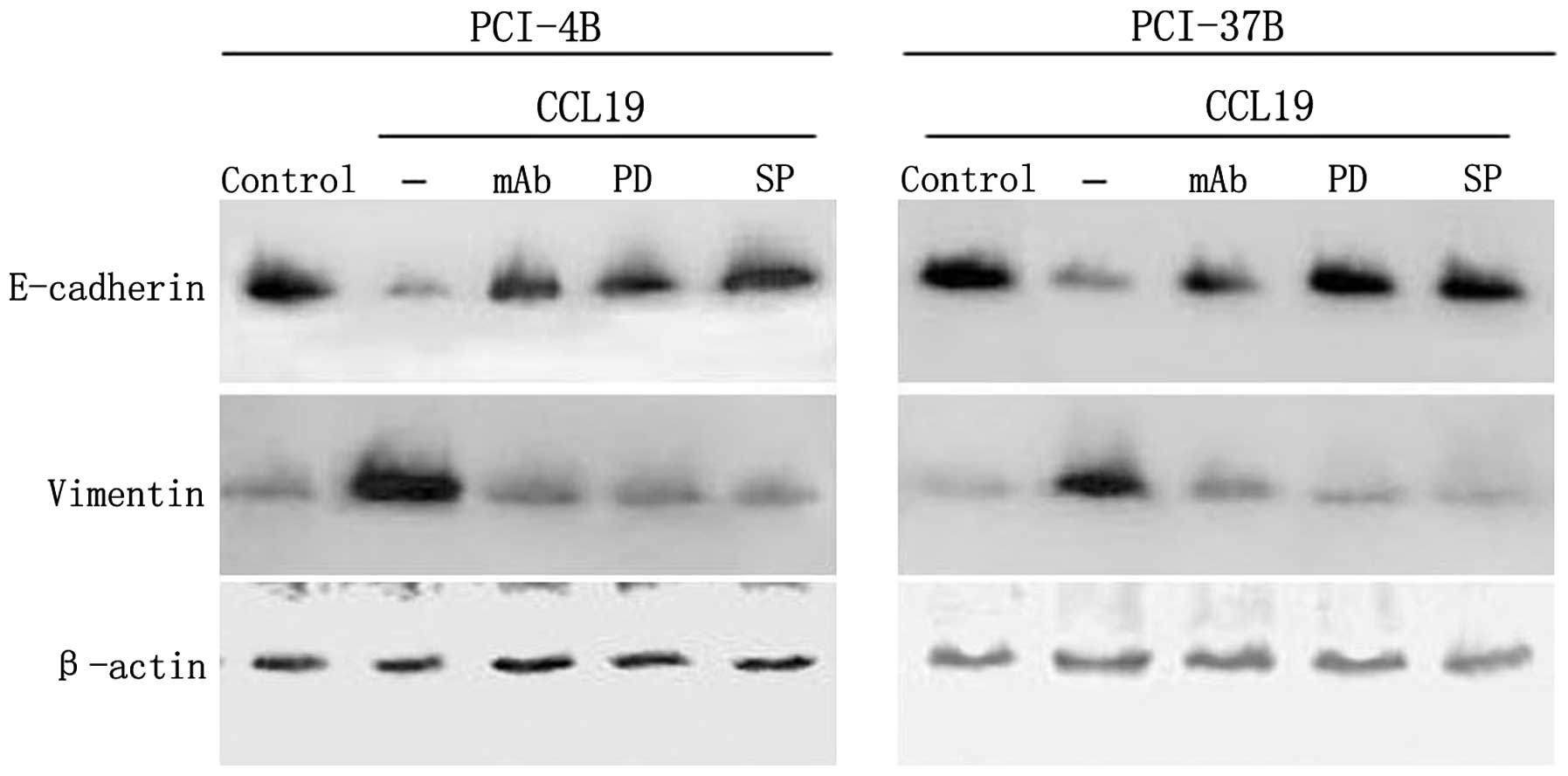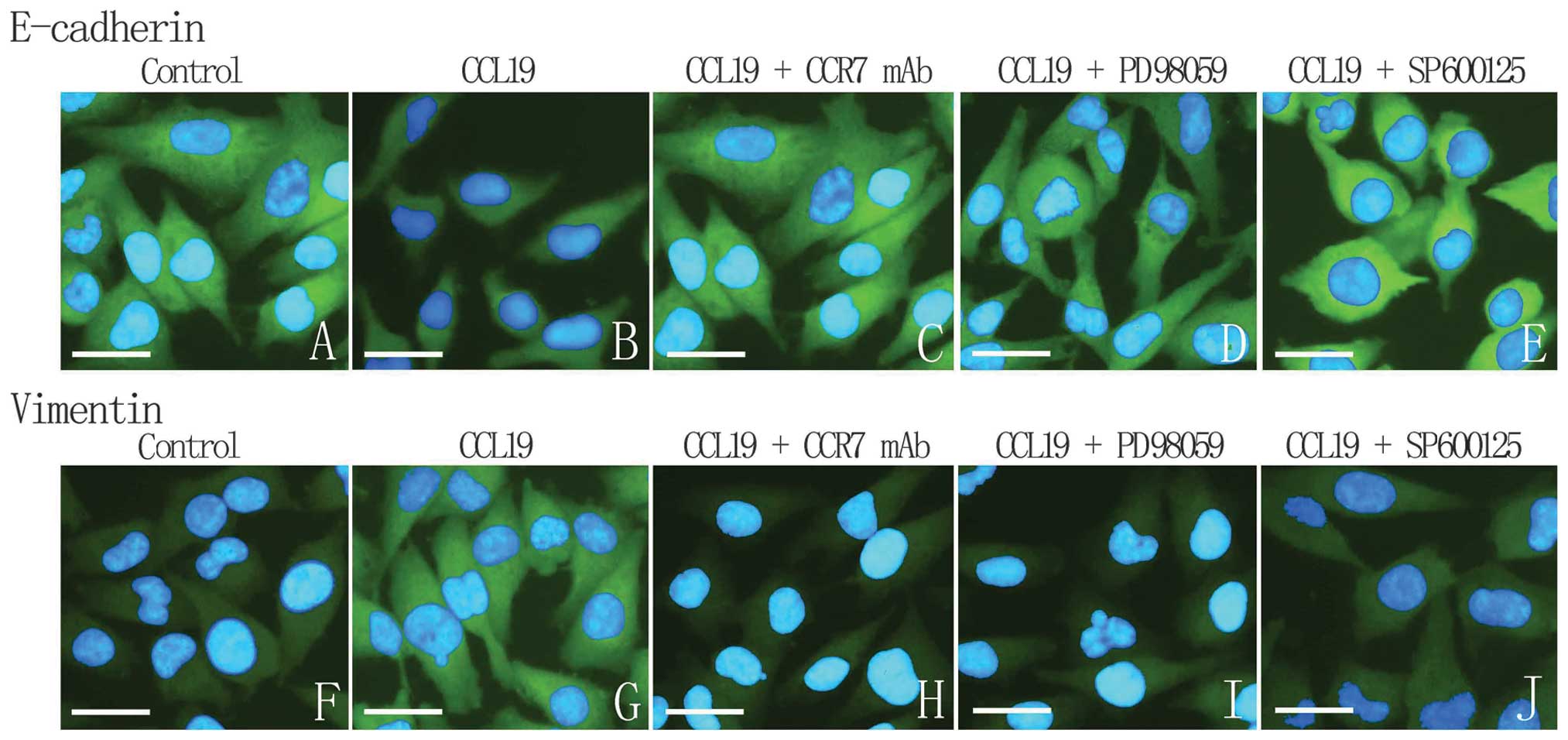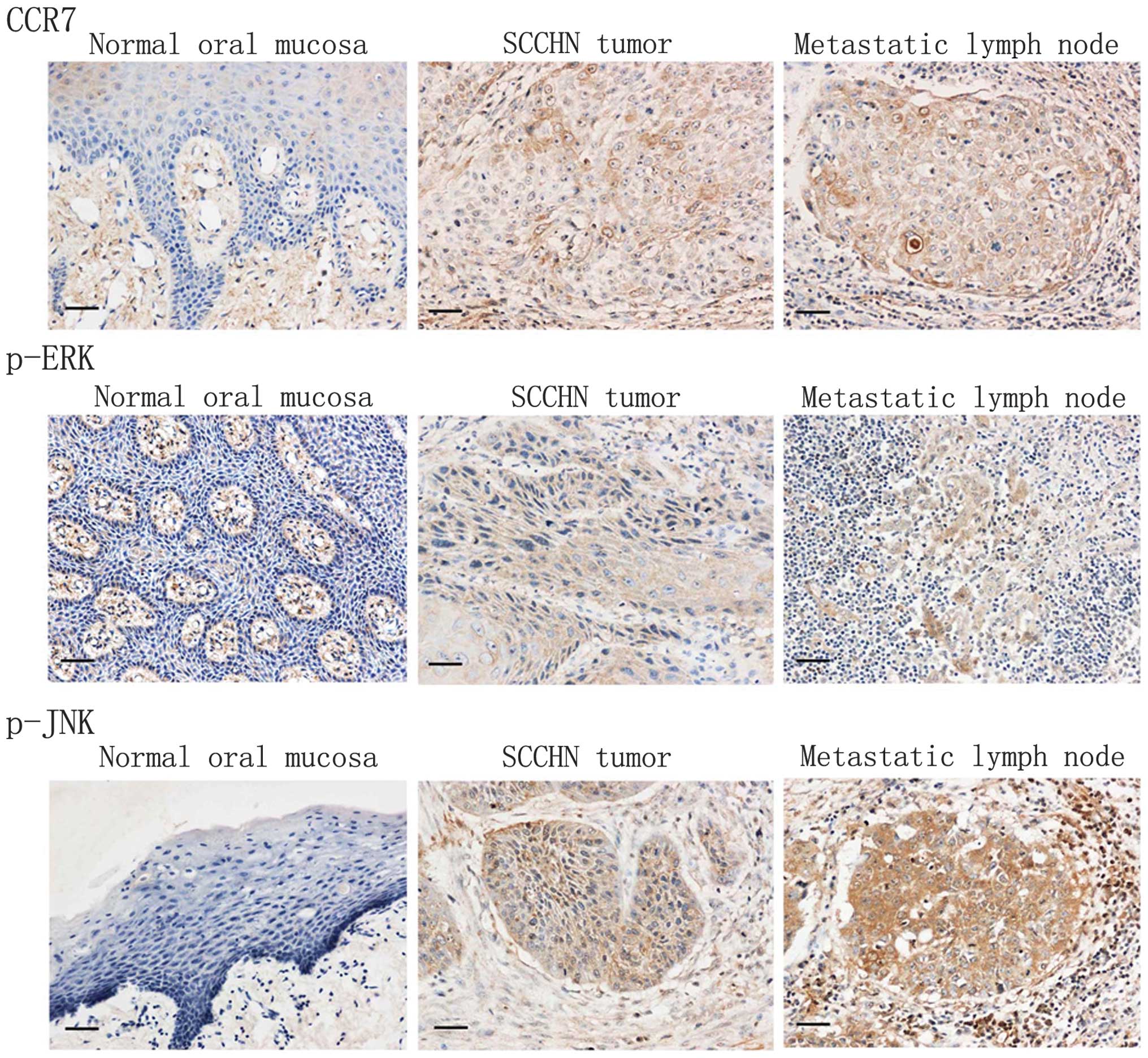CCR7 regulates cell migration and invasion through MAPKs in metastatic squamous cell carcinoma of head and neck
- Authors:
- Published online on: September 25, 2014 https://doi.org/10.3892/ijo.2014.2674
- Pages: 2502-2510
Abstract
Introduction
Squamous cell carcinoma of head and neck (SCCHN), a malignant tumor of epithelial origin, represents >90% of all head and neck cancers. The 5-year survival rate is only 30–40% in SCCHN, the main reasons are invasion and metastasis, especially metastasis to lymph nodes (1). The mechanisms leading to SCCHN metastasis are incompletely understood.
Chemokines are a group of small, structurally-related molecules that constitute a superfamily of inducible, secreted, proinflammatory proteins that are involved in a variety of immune responses (2–5). Chemokines are classified into four major groups based on the number and spacing of conserved cysteines: CXC, CC, C and CX3C. The CC chemokine receptor 7 (CCR7) has two ligands: CCL19 and CCL21. The interaction between CCR7 and its ligands promotes the migration, invasion and chemotaxis of T cells, B cells, natural killer cells (NK cells), mature dendritic cells (DC) and some tumors (6–9). The tumors affected by this interaction include: esophageal squamous cell carcinoma, colorectal carcinoma, non-small cell lung cancer, hepatocellular cancer, breast cancer, and melanoma (10–15). We have reported that CCR7 regulates cell migration and adhesion in metastatic SCCHN by activating integrin αvβ3, integrin β1 and PI3K/cdc42 (16–24). However, when these downstream molecules are inhibited, the role of CCR7 could not be blocked completely. Thus, we hypothesize there may be other molecules in the CCR7 signal pathway.
Generally, chemokine receptors relay intracellular signals that regulate chemotaxis through the Gi subfamily of G proteins (25). These intracellular signaling molecules include mitogen-activated protein kinase (MAPK) family members (26–28). MAPKs comprise a family of protein-serine/threonine kinases, which are highly conserved in protein structures from unicellular eukaryotic organisms to multicellular organisms, including mammals (29). Mammalian cells contain three major classes of MAPKs: ERK1/2, JNK, and p38. These molecules are important regulators of chemotaxis and/or random motility in a variety of cell types (28,30–32).
We hypothesized that MAPK members may be downstream molecules of the CCR7 pathway induced by CCL19 in SCCHN. The goals of this study were to determine whether MAPK members are activated by CCR7, the role and the molecular mechanisms of MAPK in CCR7-regulating SCCHN metastasis.
Materials and methods
Human tumor samples and cell lines
All clinical investigations were conducted according to the principles expressed in the Declaration of Helsinki. The study protocol was granted approval from the Ethics Committee of the China Medical University, and all participants provided their written informed consent to participate in this study.
SCCHN tissue specimens were obtained from 78 patients by biopsy prior to chemotherapy or radiotherapy at the Department of Oral and Maxillofacial Surgery, School and Hospital of Stomatology, China Medical University. The term ‘metastatic’ in this study refers to patients with positive lymph nodes that were recognized either at initial presentation or later based on the histopathological diagnosis after neck dissection. The classification of SCCHN, including primary tumors (T), regional lymph nodes (N), distant metastasis (M) and stage grouping, was determined according to the rules of the Union for International Cancer Control (UICC) for head and neck cancer (Tumor node metastasis, TNM classification, 1997). Ten samples of normal tissues adjacent to the benign tumor were chosen as controls.
PCI-4B and PCI-37B, which are well-characterized SCCHN cell lines that are derived from the metastatic lymph node of SCCHN patients, were kindly donated by the University of Pittsburgh Cancer Institute (33,34). The cells were cultured in DMEM medium (Invitrogen Life Technologies, Carlsbad, CA, USA) containing 10% fetal bovine serum (Gibco, Carlsbad, CA, USA), 100 U/ml penicillin G and 100 U/ml streptomycin. When inhibitors were used, we ensured that the dosage used did not affect the viability or expression of CCR7 of the cells.
Reagents and antibodies
CCL19, CCR7 specific monoclonal antibody (mouse anti-human CCR7 antibody) were purchased from R&D Systems (Minneapolis, MN, USA), PD98059 (ERK inhibitor) was purchased from Promega Corporation (Madison, WI, USA), SP600125 (JNK inhibitor) was purchased from Biomol GmbH (Hamburg, Germany). The anti-phospho-JNK, anti-JNK, anti-phospho-ERK, anti-ERK, anti-phospho-p38 MAPK, anti-p38 MAPK, anti-E-cadherin and anti-Vimentin were purchased from Cell Signaling Technology, Inc. (Danvers, MA, USA).
Immunohistochemical staining and evaluation
Sections were deparaffinized in xylene for 10 min and were then rehydrated through graded alcohols. To inhibit endogenous peroxide activity, sections were immersed in 100% methanol containing 0.3% hydrogen peroxide for 40 min. Following immersion, sections were put in a microwave oven in a jar filled with 10 mM sodium citrate buffer (pH 6.0) for 10 min and cooled at room temperature. Sections were incubated with normal goat serum for 20 min and were then incubated with the primary antibody for 1 h. After the incubation period, sections were washed three times with PBS and were then incubated with the linking reagent (biotinylated anti-immunoglobulin; Zymed Laboratories, Inc., South San Francisco, CA, USA) at room temperature for 1 h. After being washed three times with PBS, the sections were incubated with a complex of Avidin DH and biotinlylated enzyme (Zymed Laboratories, Inc.) for 30 min. The sections were again washed three times with PBS and incubated with a medium consisting of an equal volume of 0.02% hydrogen peroxide and diaminobenzidine tetrahydrochloride (Beijing Zhongshan Golden Bridge Biotechnology Co., Ltd., Beijing, China) for 1 min in the dark. After chromogen development, sections were washed in water and counterstained with hematoxylin. The stained slides were investigated independently by two pathologists who had no knowledge of the clinical parameters and outcomes. All these cells were scored as negative (−) (<10% or no staining), weak positive (+) (11–50%), positive (++) (51–75%), or strongly positive (+++) (>75%).
Western blotting
Cells were harvested in a lysis buffer (10 mM tris(hydroxymethyl)aminomethane (Tris) HCl, pH 7.6, 50 mM Na4P2O7, 50 mM NaF, 1 mM NaV3O4, 1% Triton X-100 and 1X protease inhibitor of protein tyrosine phosphatases). Lysates were sonicated for 3 sec and centrifuged at 4°C, 14,000 rpm for 30 min. The supernatant was collected for protein quantification using the Bio-Rad Protein Assay dye reagent (Bio-Rad Laboratories, Richmond, CA, USA). Protein (50 μg) was size-fractionated through a 10% SDS-PAGE gel and transferred onto nitrocellulose filters. The filters were blocked (1% non-fat dry milk, 0.1% Triton X-100, 150 mM NaCl, 50 mM Tris (pH 7.5) and incubated with the primary antibody, which was diluted to a ratio of 1:1,000. Nitrocellulose filters were incubated with horseradish peroxidase-conjugated secondary antibodies. Bands were visualized using the enhanced chemiluminescence system (Amersham Pharmacia Biotech, Piscataway, NJ, USA) and quantified by scanning densitometry using FlourChem V2.0 software.
Immunostaining and fluorescence microscopy
Cells were fixed in 4% paraformaldehyde in PBS (10 min at room temperature) and permeabilized with 0.2% Triton X-100 (10 min at room temperature). Cells were then incubated individually in anti-E-cadherin or anti-Vimentin (1 h at room temperature) and FITC-conjugated immunoglobulins (1 h at room temperature). Cell nuclei were stained by DAPI. Representative fields of cells were photographed by fluorescence microscopy.
Migration assay
Disposable 24-well Transwell inserts with 8 μm pore size were run in triplicate in DMEM with 0.5% (w/v) BSA. Aliquots of the chemokine CCL19 were added to the lower chamber at a concentration of 500 ng/ml. The inhibitors-pre-treated PCI-4B and PCI-37B cell suspensions (2×105) were placed in the top of inserts. After 24 h of incubation, the cells on the upper surface of inserts were removed with a cell harvester, and the membrane was washed with medium. Cells that penetrated the membrane were fixed with ice-cold methanol, stained with 0.5% crystal violet, photographed, and counted under the microscope. Mean ± standard deviation (SD) was recorded for each condition and migration index was calculated based on the control, random migration.
Matrigel invasion assay
Cell invasion was quantified in vitro using Matrigel-coated semipermeable, modified inserts with a pore size of 8 μm. The analysis of Matrigel invasion assay was performed as described in the migration assay incubated with CCL19 for 36 h. Mean ± SD was recorded for each condition and invasion index was calculated based on the control, random invasion.
Wound-healing assay
SCCHN cells were plated in a 24-well plate at initial density of 1.5×105 cells/cm2. A uniform monolayer formed in 2–3 days. The wounding assays were performed in a serum-free medium. A micropipette tip was used to create a wound in the monolayer by scrapping. The relative cell free area was calculated based on the control group.
Statistical analysis
Data were expressed as the mean ± SD of repeated assays. The correlation was analyzed using the Spearman’s test and χ2 test. Statistical differences between the two groups were evaluated using an unpaired Student’s t-test. P<0.05 were considered to be significant. All statistical analyses were performed with SPSS 11.0 software.
Results
CCR7 stimulates the phosphorylation of ERK1/2 and JNK
MAPK family members (ERK1/2, p38, and JNK) have been implicated in regulating chemotaxis in some systems and random motility in others (28,30,31). Our previous results demonstrated that CCR7 mediated SCCHN cell migration and invasion (17–19). Therefore, we analyzed whether CCR7 induced activation of MAPKs in SCCHN cells. PCI-4B and PCI-37B cells were stimulated with CCL19 for various time periods, then lysed, and the lysates were analyzed by western blotting using antibodies specific for the phosphorylated/active forms and total protein of the three MAPKs. The results showed that stimulation with CCL19 resulted in a transient and potent phosphorylation of ERK1/2 and JNK, but no effect on p38. Phosphorylation of ERK1/2 and JNK reached a maximum after 15–30 min, and returned to levels close to baseline by 60 min. Total ERK1/2, JNK, p38 and the phosphorylation of p38 had no change under the inducation (Fig. 1).
To further determine whether CCR7 regulates the activation of MAPKs, PCI-4B and PCI-37B cells were pre-treated with CCR7 mAb, the antibody can neutralize the bioactivity of CCR7. Control and CCR7 mAb-treated PCI-4B and PCI-37B cells were stimulated with CCL19, and activation of ERK1/2 and JNK was analyzed. Treatment with CCR7 mAb completely abrogated the CCL19-dependent activation of ERK1/2 and JNK (Fig. 2), indicated that its CCR7 activation stimulates the phosphorylation of ERK1/2 and JNK in SCCHN cells.
To analyze the possible relationship between ERK1/2 and JNK after stimulation of CCR7, we used pharmacological agents. PCI-4B and PCI-37B cells were pre-treated with ERK1/2 inhibitor (PD98059) and JNK inhibitor (SP600125) respectively. The results showed, PD98059 could blunt the increase of the phosphorylation of ERK1/2 induced by stimulation with CCL19, without affecting JNK, and SP600125 could blunt the increase of the phosphorylation of JNK, without affecting ERK1/2, indicating that ERK1/2 and JNK activated independently (Fig. 2).
ERK1/2 and JNK regulate CCR7-dependent migration and invasion
Our previous results have shown that CCL19 induces PCI-4B and PCI-37B cell migration and invasion, and this can be blocked by CCR7 mAb (17,19) (Figs. 3 and 4). In this study, we examined whether ERK1/2 and JNK were involved in regulating the migratory and invasive speed induced by CCR7 activation. The results showed, the cell invasion index induced by CCL19 was almost three times that of the control group, and the inhibition of ERK1/2 and JNK significantly blocked the effect of CCL19 in both cell lines, leading to decreased cell invasion to almost the baseline, as well as CCR7 mAb (Fig. 3). The migration index was the same as the invasion index. The CCL19 induced migration was significantly blocked by the ERK1/2 and JNK inhibitors (Fig. 4). We also used the wound-healing assay that requires both migration and proliferation of cells. The defined lesions were generated in subconfluent layers of cells and the repopulation of denuded areas was studied. After 12 and 24 h, the gap started to close slowly in the control group, and in the CCL19 group the gap closure was accelerated, and almost merged. After the inhibitor of ERK1/2 and JNK were pre-treated, the cell migration and proliferation decreased significantly, free area was even larger than the control group (Fig. 5). The results indicated that ERK1/2 and JNK regulate CCR7-depedent migration and invasion.
ERK1/2 and JNK mediate the expression levels of E-cadherin and Vimentin induced by CCR7
CCL19 can induce SCCHN cell migration and invasion. E-cadherin and Vimentin are known to associate with epithelial-mesenchymal transition (EMT), a key point in tumor progress, and to generally participate in migration and invasion. Our results showed that CCL19-treated PCI-4B and PCI-37B cells led to a significant increase in the level of Vimentin protein and a significant decrease in the level of E-cadherin, which can be reversed by CCR7 mAb, implying that CCR7-induced cell migration and invasion may be through E-cadherin and Vimentin expression. After the inhibitor of ERK1/2 and JNK were pre-treated, CCL19-induced high expression of Vimentin was decreased and low expression of E-cadherin was increased (Fig. 6). Combined with previous results, we think ERK1/2 and JNK mediate the expression levels of E-cadherin and Vimentin induced by CCR7, and this pathway may play a key role in SCCHN metastasis.
To demonstrate this conclusions further, we designed an immunofluorescence assay. As Fig. 7 shows, the control cells contacted each other and the immunostaining of E-cadherin is very strong. CCL19 group presents no cell-cell contact, and the E-cadherin expression is very low and diffused. When pre-treated with CCR7 mAb, the inhibitors of ERK1/2 or JNK, the E-cadherin expression becomes stronger, although CCL19 induced. On the contrary, control group exhibited diffuse and low cytoplasmic Vimentin staining. In response to CCL19, a network of Vimentin filaments spanning the cell and establishing cell-to-cell contacts was observed. Application of CCR7, ERK1/2 or JNK inhibitor blocked CCL19-induced Vimentin fiber formation and restored the cellular distribution pattern to that under control conditions.
CCR7 and phosphorylation of ERK1/2 and JNK expressed by immunohistochemical staining had significant positive correlation in tumor tissues
Firstly, we studied the expression of CCR7 and phosphorylation of ERK1/2 and JNK in specimens from SCCHN patients by immunohistochemical staining. As Fig. 8 shows, in normal mucosa, CCR7 and phosphorylation of ERK1/2 and JNK were almost not stained. However, CCR7 was strongly immunolocalized in the membrane and the cytoplasm of cancer cells, and phosphorylation of ERK and JNK were detected in the nucleus and the cytoplasm. In metastatic lymph nodes, they were all highly expressed in tumor cells. Of the 78 patients, 48 cases were positive for CCR7 (48/78), and 46 cases were positive for phosphorylation of ERK1/2 (46/78), 41 cases were positive for phosphorylation of JNK (41/78). However, in ten control cases, CCR7, ERK1/2 and JNK phosphorylation was noted only in one case (1/10). SCCHN and normal tissues have significant difference in the expression of CCR7, phosphorylation of ERK1/2 and phosphorylation of JNK (P<0.05). Table I summarizes the relationship between CCR7 expression, phosphorylation of ERK1/2 and JNK, and the clinicopathological factors of the 78 SCCHN patients. The expression of CCR7, phosphorylation of ERK1/2 and JNK were all significantly correlated with cervical lymph node metastasis and clinical stage (P<0.05), and had no significant difference with age or gender (P>0.05). Furthermore, our data also suggested that the phosphorylation of ERK1/2 and JNK was correlated with CCR7 expression, respectively (P<0.05) (Table II).
Table ICorrelations between CCR7, ERK1/2 phosphorylation, JNK phosphorylation and the clinicopathological factors of SCCHN. |
Table IICorrelations between CCR7 expression, ERK1/2 phosphorylation and JNK phosphorylation in SCCHN primary tumor. |
Discussion
Metastasis involves the separation from the primary tumor, migration into the extracellular matrix, blood vessel invasion, adhesion to endothelium and extravasation and growth in a secondary organ (35). Therefore, these steps will regulate cancer cells metastasis. CCL19 is expressed constitutively within lymphoid tissues (36). The interaction of CCR7 and CCL19 promotes cell migration and adhesion in metastatic SCCHN (17–19). However, the mechanisms of adhesion and migration and the signaling pathway involved remains poorly understood.
MAPKs regulate many physiological processes in response to diverse stimuli including cytokines, growth factors, antigens, toxins, drugs, cell shape, adherence to extracellular matrix, and cell-cell interactions. The activation of MAPKs in response to these diverse stimuli contributes to the control of transcription, proliferation, development, cell death, motility, and many other important regulatory responses in cells. To control such diverse biological responses, MAPKs are activated and inactivated with spatial and temporal accuracy within the cell (37). Riol-Blanco et al investigated the intracellular pathways that regulate CCR7-dependent chemotaxis and migratory speed in DCs, and found that CCR7 induced a G(i)-dependent activation of MAPK members ERK1/2, JNK, and p38, with ERK1/2 and p38 controlling JNK (38). Recently, Shannon et al reported that the CCR7 signaling pathway leading to T-lymphocyte migration on fibronectin is a β1 integrin-dependent pathway involving ERK1/2 phosphorylation (39). Our results also showed that, in solid tumor (SCCHN), stimulation of CCL19 and the activation of CCR7 can induce ERK1/2 and JNK phosphorylation, while has no effect on p38, suggesting ERK1/2 and JNK may be the downstream signaling pathway of CCR7 in SCCHN. Furthermore, the phosphorylation of ERK1/2 or JNK did not influence each other, suggesting the two molecules participate in the signaling pathway independently. In DC, ERK1/2, JNK, and p38 only regulated chemotaxis, but not the migratory speed (38), and in B-cell chronic lymphocytic leukemia, ERK1/2 participates in CCL21-dependent migration and invasion simultaneously (40). In our results, ERK1/2 and JNK not only mediated CCR7-induced cell migration, but also mediated the speed of invasion.
MAPKs are members of a three-kinase phosphorylate system composed of the MAPK, MAPK kinase (MKK) and MAPK kinase kinase (MKKK). MKKKs phosphorylate and activate MKKs, which in turn phosphorylate and activate MAPKs. Scaffolding proteins organize MKK-MAPK complexes for activation by specific MKKKs and do so in specific locations in the cell. It is the MKKK associated with the scaffolded complex that provides selectivity for activation by upstream stimuli including GTPases, additional kinases and receptors (41).
The activation of MKK-MAPK complexes regulate the physiological processes by many target proteins. E-cadherin is a transmembrane glycoprotein associated with the cytoskeleton via cytoplasmic proteins. Normal squamous epithelium of the esophagus showed strong E-cadherin/β-catenin expression especially on cell-cell boundaries except in the superficial layer (42). EMT plays an important role in tumor prognosis, known to dismantle cadherin-medicated cell-cell junctions (43). Thus, disruption of E-cadherin-mediated adhesion is considered as a key step in the progression toward the malignant phase of carcinoma (44). In ovarian cancer, it has been shown that E-cadherin is downregulated by epidermal growth factor (EGF) receptor (EGFR) activation via p38 MAPK, and that cells with low E-cadherin expression are particularly invasive (45). In human oral squamous cancer CAL-27 cells, treatment with the ERK inhibitor could also upregulate the expression of the E-cadherin molecule. Vimentin, the major intermediate filament (IF) protein of mesenchymal cells, is also associated with EMT. In lung cancer, transforming growth factor-β1-induced EMT was reversed by ERK inhibitor by attenuating the expression of Vimentin (46). In our study, the CCR7-induced ERK and JNK activation downregulated E-cadherin and upregulated Vimentin expression simultaneously, and then affected cell-cell contact and expansion. Therefore, we presumed that E-cadherin and Vimentin are ERK and JNK downstream target molecules in CCR7 regulating SCCHN cell migration and invasion, and this MAPK pathway may generally participate in tumor cells separated from the primary tumor, migrating into extracellular matrix, invading blood vessels and adhering to the endothelium. The immunohistochemistry results not only showed that CCR7 was correlated with the phosphorylation of ERK1/2 and JNK in SCCHN, but also showed that these molecules are all associated with lymph node metastasis. This confirmed the results in vitro.
Taken together, our study supports a hypothesis that CCR7 regulate SCCHN metastasis via MAPK members (ERK1/2 and JNK). However, signaling pathways controlling directional cell migration are not linear, but integrate signals from a plethora of upstream switches into a molecular matrix, resulting in complex cellular responses. Further study is required to elucidate the sequence of events leading to the CCR7-mediated metastatic phenotype, which will enable the development of therapeutic strategies aiming at blocking these carcinogenic and metastatic effects.
Acknowledgements
This research was supported by grants from the National Natural Science Foundation of China (No. 81372877), the National Young Scholars Science Foundation of China (No. 81102058), the Foundation of Education Bureau of Liaoning Province (No. 2009A755, No. L2014317), the Public Welfare Fund Project for Science of Liaoning Province (No. 2011002001), Natural Science Foundation of Liaoning Province (No. 2014021096), and Excellent Talent Fund Project of Higher Education of Liaoning Province (LJQ2014087).
References
|
Greenlee RT, Hill-Harmon MB, Murray T and Thun M: Cancer statistics, 2001. CA Cancer J Clin. 51:15–36. 2001. View Article : Google Scholar | |
|
Butcher EC, Williams M, Youngman K, Rott L and Briskin M: Lymphocyte trafficking and regional immunity. Adv Immunol. 72:209–253. 1999. View Article : Google Scholar : PubMed/NCBI | |
|
Campbell JJ and Butcher EC: Chemokines in tissue-specific and microenvironment-specific lymphocyte homing. Curr Opin Immunol. 12:336–341. 2000. View Article : Google Scholar : PubMed/NCBI | |
|
Morales J, Homey B, Vicari AP, et al: CTACK, a skin-associated chemokine that preferentially attracts skin-homing memory T cells. Proc Natl Acad Sci USA. 96:14470–14475. 1999. View Article : Google Scholar : PubMed/NCBI | |
|
Zlotnik A and Yoshie O: Chemokines: a new classification system and their role in immunity. Immunity. 12:121–127. 2000. View Article : Google Scholar : PubMed/NCBI | |
|
Mburu YK, Abe K, Ferris LK, Sarkar SN and Ferris RL: Human β-defensin 3 promotes NF-κB-mediated CCR7 expression and anti-apoptotic signals in squamous cell carcinoma of the head and neck. Carcinogenesis. 32:168–174. 2011. | |
|
Nagira M, Imai T, Yoshida R, et al: A lymphocyte-specific CC chemokine, secondary lymphoid tissue chemokine (SLC), is a highly efficient chemoattractant for B cells and activated T cells. Eur J Immunol. 28:1516–1523. 1998. View Article : Google Scholar : PubMed/NCBI | |
|
Iijima N, Yanagawa Y, Clingan JM and Onoé K: CCR7-mediated c-Jun N-terminal kinase activation regulates cell migration in mature dendritic cells. Int Immunol. 17:1201–1212. 2005. View Article : Google Scholar : PubMed/NCBI | |
|
Emmett MS, Lanati S, Dunn DB, Stone OA and Bates DO: CCR7 mediates directed growth of melanomas towards lymphatics. Microcirculation. 18:172–182. 2011. View Article : Google Scholar : PubMed/NCBI | |
|
Ding Y, Shimada Y, Maeda M, et al: Association of CC chemokine receptor 7 with lymph node metastasis of esophageal squamous cell carcinoma. Clin Cancer Res. 9:3406–3412. 2003.PubMed/NCBI | |
|
Takanami I: Overexpression of CCR7 mRNA in nonsmall cell lung cancer: correlation with lymph node metastasis. Int J Cancer. 105:186–189. 2003. View Article : Google Scholar : PubMed/NCBI | |
|
Murakami T, Cardones AR and Hwang ST: Chemokine receptors and melanoma metastasis. J Dermatol Sci. 36:71–78. 2004. View Article : Google Scholar | |
|
Gunther K, Leier J, Henning G, et al: Prediction of lymph node metastasis in colorectal carcinoma by expression of chemokine receptor CCR7. Int J Cancer. 116:726–733. 2005. View Article : Google Scholar : PubMed/NCBI | |
|
Cabioglu N, Yazici MS, Arun B, et al: CCR7 and CXCR4 as novel biomarkers predicting axillary lymph node metastasis in T1 breast cancer. Clin Cancer Res. 11:5686–5693. 2005. View Article : Google Scholar : PubMed/NCBI | |
|
Schimanski CC, Bahre R, Gockel I, et al: Chemokine receptor CCR7 enhances intrahepatic and lymphatic dissemination of human hepatocellular cancer. Oncol Rep. 16:109–113. 2006.PubMed/NCBI | |
|
Zhao ZJ, Li P, Liu FY, Sun LY and Sun CF: PKCα take part in CCR7/NF-κB autocrine signaling loop in CCR7-positive squamous cell carcinoma of head and neck. Mol Cell Biochem. 357:181–187. 2011. | |
|
Zhao ZJ, Liu FY, Li P, Ding X, Zong ZH and Sun CF: CCL19-induced chemokine receptor 7 activates the phosphoinositide-3 kinase-mediated invasive pathway through Cdc42 in metastatic squamous cell carcinoma of the head and neck. Oncol Rep. 25:729–737. 2011.PubMed/NCBI | |
|
Li P, Zhao ZJ, Liu FY, et al: The chemokine receptor 7 regulates cell adhesion and migration via beta1 integrin in metastatic squamous cell carcinoma of the head and neck. Oncol Rep. 24:989–995. 2010.PubMed/NCBI | |
|
Li P, Liu F, Sun L, et al: Chemokine receptor 7 promotes cell migration and adhesion in metastatic squamous cell carcinoma of the head and neck by activating integrin αvβ3. Int J Mol Med. 27:679–687. 2011.PubMed/NCBI | |
|
Liu FY, Zhao ZJ, Li P, Ding X, Zong ZH and Sun CF: Mammalian target of rapamycin (mTOR) is involved in the survival of cells mediated by chemokine receptor 7 through PI3K/Akt in metastatic squamous cell carcinoma of the head and neck. Br J Oral Maxillofac Surg. 48:291–296. 2010. View Article : Google Scholar : PubMed/NCBI | |
|
Liu FY, Zhao ZJ, Li P, Ding X and Sun CF: Effect of rapamycin combined with cisplatin on head and neck squamous cancer cells regulated by CCL19. Zhonghua Kou Qiang Yi Xue Za Zhi. 46:197–200. 2011.(In Chinese). | |
|
Liu FY, Zhao ZJ, Li P, Ding X and Sun CF: The effect of CCL19 on the viability of head and neck squamous cancer cells. Shanghai Kou Qiang Yi Xue. 19:158–161. 2010.(In Chinese). | |
|
Liu FY, Zhao ZJ, Li P, et al: NF-κB participates in chemokine receptor 7-mediated cell survival in metastatic squamous cell carcinoma of the head and neck. Oncol Rep. 25:383–391. 2011. | |
|
Liu FY, Zhao ZJ, Huang SH and Sun CF: Role of PDTC in CCL19 regulating the activity of human head and neck squamous cancer cells. J Chin Med Univ. 37:847–849. 2008.(In Chinese). | |
|
Thelen M: Dancing to the tune of chemokines. Nat Immunol. 2:129–134. 2001. View Article : Google Scholar : PubMed/NCBI | |
|
Ganju RK, Brubaker SA, Meyer J, et al: The alpha-chemokine, stromal cell-derived factor-1alpha, binds to the transmembrane G-protein-coupled CXCR-4 receptor and activates multiple signal transduction pathways. J Biol Chem. 273:23169–23175. 1998. View Article : Google Scholar : PubMed/NCBI | |
|
Ganju RK, Dutt P, Wu L, et al: Beta-chemokine receptor CCR5 signals via the novel tyrosine kinase RAFTK. Blood. 91:791–797. 1998.PubMed/NCBI | |
|
Wong MM and Fish EN: Chemokines: attractive mediators of the immune response. Semin Immunol. 15:5–14. 2003. View Article : Google Scholar : PubMed/NCBI | |
|
Huang P, Han J and Hui L: MAPK signaling in inflammation-associated cancer development. Protein Cell. 1:218–226. 2010. View Article : Google Scholar : PubMed/NCBI | |
|
Klemke RL, Cai S, Giannini AL, Gallagher PJ, de Lanerolle P and Cheresh DA: Regulation of cell motility by mitogen-activated protein kinase. J Cell Biol. 137:481–492. 1997. View Article : Google Scholar : PubMed/NCBI | |
|
Huang C, Rajfur Z, Borchers C, Schaller MD and Jacobson K: JNK phosphorylates paxillin and regulates cell migration. Nature. 424:219–223. 2003. View Article : Google Scholar : PubMed/NCBI | |
|
Wang H, Wu C, Wan S, Zhang H, Zhou S and Liu G: Shikonin attenuates lung cancer cell adhesion to extracellular matrix and metastasis by inhibiting integrin β1 expression and the ERK1/2 signaling pathway. Toxicology. 308:104–112. 2013.PubMed/NCBI | |
|
Wang J, Zhang X, Thomas SM, et al: Chemokine receptor 7 activates phosphoinositide-3 kinase-mediated invasive and prosurvival pathways in head and neck cancer cells independent of EGFR. Oncogene. 24:5897–5904. 2005. View Article : Google Scholar : PubMed/NCBI | |
|
Mburu YK, Wang J, Wood MA, Walker WH and Ferris RL: CCR7 mediates inflammation-associated tumor progression. Immunol Res. 36:61–72. 2006. View Article : Google Scholar : PubMed/NCBI | |
|
Liotta LA, Steeg PS and Stetler-Stevenson WG: Cancer metastasis and angiogenesis: an imbalance of positive and negative regulation. Cell. 64:327–336. 1991. View Article : Google Scholar : PubMed/NCBI | |
|
Ngo VN, Tang HL and Cyster JG: Epstein-Barr virus-induced molecule 1 ligand chemokine is expressed by dendritic cells in lymphoid tissues and strongly attracts naive T cells and activated B cells. J Exp Med. 188:181–191. 1998. View Article : Google Scholar : PubMed/NCBI | |
|
Johnson GL: Defining MAPK interactomes. ACS Chem Biol. 6:18–20. 2011. View Article : Google Scholar | |
|
Riol-Blanco L, Sánchez-Sánchez N, Torres A, et al: The chemokine receptor CCR7 activates in dendritic cells two signaling modules that independently regulate chemotaxis and migratory speed. J Immunol. 174:4070–4080. 2005. View Article : Google Scholar : PubMed/NCBI | |
|
Shannon LA, Calloway PA, Welch TP and Vines CM: CCR7/CCL21 migration on fibronectin is mediated by phospholipase Cgamma1 and ERK1/2 in primary T lymphocytes. J Biol Chem. 285:38781–38787. 2010. View Article : Google Scholar : PubMed/NCBI | |
|
Redondo-Muñoz J, José Terol M, García-Marco JA and García-Pardo A: Matrix metalloproteinase-9 is up-regulated by CCL21/CCR7 interaction via extracellular signa-lregulated kinase-1/2 signaling and is involved in CCL21-driven B-cell chronic lymphocytic leukemia cell invasion and migration. Blood. 111:383–386. 2008. | |
|
Johnson GL, Dohlman HG and Graves LM: MAPK kinase kinases (MKKKs) as a target class for small-molecule inhibition to modulate signaling networks and gene expression. Curr Opin Chem Biol. 9:325–331. 2005. View Article : Google Scholar : PubMed/NCBI | |
|
Takayama T, Shiozaki H, Shibamoto S, et al: Beta-catenin expression in human cancers. Am J Pathol. 148:39–46. 1996. | |
|
Savagner P: Leaving the neighborhood: molecular mechanisms involved during epithelial-mesenchymal transition. Bioessays. 23:912–923. 2001. View Article : Google Scholar : PubMed/NCBI | |
|
Behrens J: Cadherins and catenins: role in signal transduction and tumor progression. Cancer Metastasis Rev. 18:15–30. 1999. View Article : Google Scholar : PubMed/NCBI | |
|
Cheng JC, Klausen C and Leung PC: Hydrogen peroxide mediates EGF-induced down-regulation of E-cadherin expression via p38 MAPK and snail in human ovarian cancer cells. Mol Endocrinol. 24:1569–1580. 2010. View Article : Google Scholar : PubMed/NCBI | |
|
Chen XF, Zhang HJ, Wang HB, et al: Transforming growth factor-β1 induces epithelial-to-mesenchymal transition in human lung cancer cells via PI3K/Akt and MEK/Erk1/2 signaling pathways. Mol Biol Rep. 39:3549–3556. 2011. |



